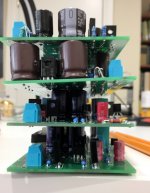Any idea when this circuit will be ready I already have the Edcor transformer a pair of 2sj28's or for that mater a pair of 2sk180's just begging to be used.
Initial units are 2SK28, lucky boy.
Parts arriving daily. Final production boards in couple weeks.

Parts arriving daily. Final production boards in couple weeks.

I wasn't 100% clear - will the 2SJ28s be included in the kit when it's ready, or will we have to find them ourselves?
From Nelson's post #3
"Those out there with VFETs already will be able to get kits without that
part."
"Those out there with VFETs already will be able to get kits without that
part."
but.... IIRC, 100 or 200 channels of SJ28 FETS included (priced) in the initial run. When they're gone they're gone, probably just PCBs in the store afterward.
If you are asking whether Nelson Pass designed the amplifiers, laid out the PCBs, and tested the prototypes, without ever drawing any schematic: the answer is no.
If you are asking whether those schematics have been publicly released yet: the answer is also no.
If you are asking whether those schematics have been publicly released yet: the answer is also no.
If it will be sold in kit a schema sould be available....
nope we build blind like ZM 😀😀
For some reason numerous discerning audiophiles like the Edcor in spite of the lesser objective performance, and I don't think it has anything to do with
price.
Anyway, looks like you will have some options. Mark Johnson has agreed to work on some different front ends that will mount on the sink in addition to the Edcor circuit.
Done. In the leisurely interval between 20 July and 30 September. Just now I snapped a cellphone photo of four different front end cards, sorry for the potato quality of the picture. Each board works, they all play music, they decline to oscillate, they make nice looking waveforms on a scope. Bottom to top, their PCB-IDs are "S", "B", "M", "D" .
Technical details won't be provided until (A) the actual VFET amplifier itself has been released & NP has described its principles of operation; and also (B) the front end cards have been successful mated with the VFET amplifier boards. Who knows, one or more of the front ends might not pass this final test.
_
Attachments
I was under the impression that the `magic' in Vfets is the production of simple harmonics when used in common source mode. Does use as a follower provide similar set of unusual benefits that derive from use of a Vfet?
Keenly awaiting being edukated.
Keenly awaiting being edukated.
The VFET still operates according to its characteristic curves. Of course, the distortion profile will vary depending on its operating point and load line.
With choices of "B", "D", "S", or "M"; I supposed there's a little something to satisfy most audio fetishes. I hope none of them are too harsh.
I'll see myself out.
I'll see myself out.
Mark, thank you for your hard work on this. I suspect many builders will have much
fun playing with the front ends.
fun playing with the front ends.
The VFET still operates according to its characteristic curves. Of course, the distortion profile will vary depending on its operating point and load line.
I agree. I tried both common source and common drain with Sony and Tokin, and it seems that the operating point has more impact than cs vs cd. The difference in damping factor affects the character of the bottom end, though.
- Home
- Amplifiers
- Pass Labs
- Simple SE Sit Amp
